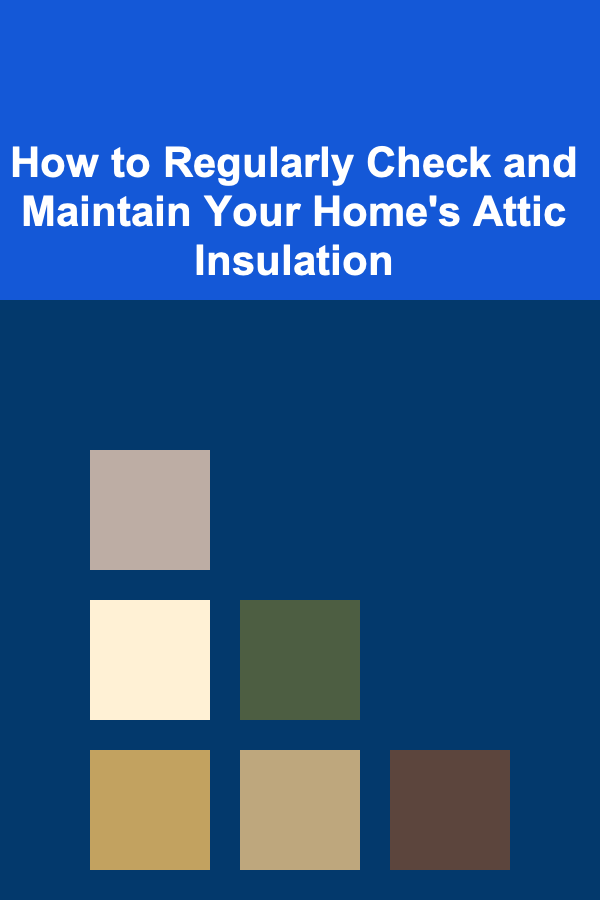
How to Regularly Check and Maintain Your Home's Attic Insulation
ebook include PDF & Audio bundle (Micro Guide)
$12.99$11.99
Limited Time Offer! Order within the next:

Proper insulation is one of the most crucial components of maintaining an energy-efficient home. Among the various forms of insulation, attic insulation plays a key role in regulating your home's temperature, reducing energy costs, and preventing issues like moisture buildup and pest infiltration. However, many homeowners often overlook the importance of regular attic insulation checks. This oversight can lead to energy inefficiencies, higher utility bills, and potential structural damage to the home.
In this article, we will explore how to regularly check and maintain your attic insulation to ensure that it functions effectively for years to come. From understanding different types of attic insulation to performing routine inspections and making necessary repairs, we will provide a comprehensive guide on how to keep your attic well-insulated and energy-efficient.
Understanding the Importance of Attic Insulation
Before delving into how to maintain your attic insulation, it's important to first understand why insulation is so essential. Insulation helps maintain your home's internal temperature by reducing heat loss in winter and preventing heat gain in summer. In an uninsulated or poorly insulated attic, hot air escapes during the winter, while in the summer, hot air seeps into the home, forcing your heating and cooling systems to work overtime.
Attic insulation provides a thermal barrier that prevents these heat exchanges, which is essential for energy efficiency. Furthermore, attic insulation can also help prevent moisture buildup, which can lead to mold growth and wood rot. Proper insulation also enhances the comfort of your living space by keeping rooms warmer in the winter and cooler in the summer.
Types of Attic Insulation
There are several types of attic insulation, each with its unique properties and advantages. The choice of insulation for your attic depends on several factors, including climate, budget, and the current state of your attic. Below are the most common types of attic insulation:
1. Batt Insulation (Fiberglass or Mineral Wool)
Batt insulation consists of pre-cut rolls or batts of insulation material, typically made from fiberglass or mineral wool. These batts are placed between the framing of the attic and are suitable for attics with standard spacing. Fiberglass batt insulation is the most common type used in homes because it is inexpensive, easy to install, and effective at reducing heat transfer. However, fiberglass insulation can settle over time, which may reduce its overall effectiveness.
2. Blown-In Insulation (Loose-Fill)
Blown-in insulation, also known as loose-fill insulation, is made from materials such as cellulose, fiberglass, or mineral wool. It is installed by blowing the insulation material into the attic using a special machine. This type of insulation is ideal for attics with irregular shapes or difficult-to-reach areas. It provides a higher level of coverage than batt insulation because it can fill gaps and corners that are hard to insulate with batts. Blown-in insulation settles less over time, making it a more long-lasting option.
3. Spray Foam Insulation
Spray foam insulation is a highly effective form of insulation that expands when applied to a surface. It creates an airtight seal and is particularly beneficial in preventing air leaks and moisture intrusion. Spray foam insulation is often used in attics with high moisture levels or where air leaks are a significant concern. It provides excellent thermal resistance (R-value) and helps maintain consistent temperatures in the attic.
4. Reflective or Radiant Barrier Insulation
Reflective or radiant barrier insulation is designed to reflect heat away from the attic during the summer months. This type of insulation is typically installed under the roof deck and helps reduce cooling costs by blocking radiant heat. Radiant barriers are most effective in warmer climates, where the primary concern is heat gain during the summer.
The Role of R-Value in Attic Insulation
When selecting or checking attic insulation, one of the most important factors to consider is the R-value. The R-value measures the thermal resistance of insulation, indicating how well it resists heat flow. The higher the R-value, the better the insulation performs at keeping heat in during the winter and out during the summer.
The recommended R-value for attic insulation varies depending on climate and the specific conditions of your home. For instance, in colder climates, higher R-values are required to combat heat loss, while in warmer climates, the focus is more on preventing heat gain.
A typical recommendation for attic insulation R-values ranges from R-30 to R-60 for most homes in temperate climates. Homeowners should check local building codes or consult with a professional to determine the appropriate R-value for their specific needs.
How to Regularly Check Your Attic Insulation
Attic insulation should be inspected at least once a year to ensure its effectiveness. Regular inspections allow homeowners to identify potential issues such as insulation settling, moisture damage, or pest infiltration. Here's a step-by-step guide on how to check your attic insulation:
1. Prepare for Inspection
Before heading up to the attic, make sure you have the necessary tools for the job. You will need:
- A flashlight to inspect dark corners
- A tape measure to check insulation thickness
- A notepad to take notes
- A moisture meter (optional) to check for signs of water damage
- Personal protective equipment (PPE) such as gloves, a dust mask, and safety glasses
2. Look for Signs of Damage
Start by looking for visible signs of damage or wear in the attic. Common issues to look for include:
- Compression: Over time, insulation can compress, losing its effectiveness. If you notice that the insulation looks flatter or thinner than it should, it may need to be replaced or topped up.
- Moisture Damage: Moisture is one of the most common causes of insulation degradation. Check for signs of wetness, mold, or mildew. If the insulation is wet, it may no longer provide effective thermal resistance and should be replaced.
- Pest Infestation: Rodents and insects can damage insulation by chewing through it or creating tunnels. Look for signs of droppings, nests, or chewed materials in the attic.
- Air Leaks: Look for gaps around vents, ducts, and electrical fixtures. These areas can allow warm or cool air to escape, making your insulation less effective. Seal any visible gaps using caulk or weatherstripping.
3. Check Insulation Depth
Use a tape measure to check the depth of the insulation. For batt insulation, the standard thickness is usually between 8 to 12 inches, depending on the type. Blown-in insulation should be thick enough to provide a uniform layer, usually between 10 to 20 inches.
If the insulation is below the recommended depth for your climate, it may be time to add more. You can either top up existing insulation or remove and replace it with a more effective material.
4. Look for Gaps or Spaces
One of the most critical things to check during your inspection is the presence of gaps or areas where insulation may be missing. Gaps allow heat to escape in winter and enter in summer, undermining the purpose of your insulation.
Ensure that insulation covers all areas of the attic, including the edges and around any obstructions like pipes, ducts, or vents. If there are areas that are not properly insulated, consider adding more material to fill the gaps.
5. Assess Ventilation
Proper attic ventilation is crucial to the effectiveness of insulation. Without adequate airflow, moisture can build up, leading to mold growth, insulation deterioration, and potential structural damage. Check for vents, soffit vents, and exhaust fans to ensure that they are not blocked by insulation.
Ensure that your attic has a proper balance of intake and exhaust ventilation to allow for air circulation. If ventilation is inadequate, you may need to install additional vents or remove excess insulation near vent openings.
How to Maintain and Repair Attic Insulation
If you identify problems during your attic inspection, addressing them promptly will prevent further damage and maintain your home's energy efficiency. Below are some common maintenance and repair tasks for attic insulation:
1. Top Up Settled Insulation
If your insulation has settled over time, you can top it up to restore its effectiveness. Adding an extra layer of blown-in insulation is the most common way to achieve this. Ensure that you do not overfill the attic, as this can block ventilation and create other issues.
2. Replace Damaged Insulation
In cases of significant moisture damage, mold growth, or pest infestation, the damaged insulation will need to be replaced. Remove the old insulation carefully, taking precautions to avoid disturbing mold spores or pests. Install new, dry insulation to restore thermal resistance.
3. Seal Gaps and Air Leaks
Use caulk or expanding foam to seal any gaps or cracks around vents, ducts, and other openings. Sealing air leaks is one of the most cost-effective ways to improve insulation performance and energy efficiency.
4. Install Radiant Barriers
In areas with particularly hot summers, installing a radiant barrier in the attic can help reduce cooling costs by reflecting heat away from the home. Radiant barriers are especially effective when combined with other insulation types like fiberglass batt or blown-in insulation.
5. Ensure Proper Ventilation
If your attic lacks adequate ventilation, install additional vents or a ridge vent system to improve airflow. Proper ventilation helps maintain the integrity of your insulation by preventing moisture buildup and ensuring that the attic remains dry and cool.
Conclusion
Regularly checking and maintaining your attic insulation is an essential task for homeowners who want to reduce energy costs and maintain a comfortable living environment. By inspecting your insulation annually, addressing signs of damage, and making necessary repairs, you can ensure that your attic insulation continues to perform optimally year-round.
Whether you're adding more insulation, sealing gaps, or installing radiant barriers, taking proactive steps to maintain your attic insulation will improve the overall efficiency of your home and increase its long-term value.
Reading More From Our Other Websites
- [Home Storage Solution 101] How to Maximize Space and Style with Clever Home Library Organization Techniques
- [Home Budget 101] How to Save Money on Electricity: A Deep Dive into Smart Home Energy Efficiency
- [Personal Financial Planning 101] How to Use a Financial Plan Builder for Long-Term Investment Planning
- [Home Pet Care 101] How to Establish a Pet Routine for a Happy Home Life
- [Biking 101] How to Choose the Best Bike Lights for Visibility and Safety
- [Home Maintenance 101] How to Create a Senior-Friendly Home: Essential Home Maintenance for Seniors
- [Whitewater Rafting Tip 101] From Calm Waters to White-Water Thrills: Turning Rafting Into a Test of Grit
- [Organization Tip 101] How to Use Mind Mapping for Project Organization
- [Hiking with Kids Tip 101] Kid-Friendly Backpack Picks: Light, Durable, and Fun Designs
- [Whitewater Rafting Tip 101] Safety First: Essential Gear and Tips for Rafting the Most Challenging Rapids

How to Make Family Time More Fun with DIY Indoor Sports
Read More
How to Onboard International Employees Successfully
Read More
How to Plan a Small Home Office That Doesn't Feel Cramped
Read More
How To Use Body Doubling for Focus
Read More
How To Open a Florist Shop: A Comprehensive Guide
Read More
10 Tips for Effective Football Game Day Preparation
Read MoreOther Products

How to Make Family Time More Fun with DIY Indoor Sports
Read More
How to Onboard International Employees Successfully
Read More
How to Plan a Small Home Office That Doesn't Feel Cramped
Read More
How To Use Body Doubling for Focus
Read More
How To Open a Florist Shop: A Comprehensive Guide
Read More